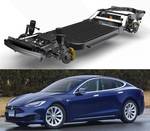STA*Research - Specialist Consultants To The Petrochemical Industry
Why Motility?
Freedom
In the McKinsey Quarterly of February, 2019, world motility is described as being at its Second Great Inflection Point. The first Great Point of Inflection occurred in the 25 years from about 1895 to 1920 during which the prime means of transport in major cities changed from the horse to the internal combustion engine (ICE). In October, 1908, Henry Ford’s Model T gave to the middle class the first affordable automobile that offered unprecedented freedom to travel wherever and whenever desired.
Although the ICE brought great freedom it also brought traffic congestion, road rage, traffic accidents, injuries, auto scrap yards, catalytic converters, smog tests, atmospheric pollution, lead poisoning, traffic noise, and climate change. To correct the bad of the ICE whilst retaining the freedom, the world needs to transition to tailpipe-free motility: battery electric vehicles (BEVs) or fuel-cell powered vehicles (FCEVs.) This transition has begun; we are at the point of inflection, moving toward autonomous driving and the elimination of the CO2-spewing ICE.
Climate Change
The three prime drivers of the Second Great Inflection are urban congestion, atmospheric pollution and global warming. The global warming challenge is immense: current plans to limit temperature rise to 1.5°C look more like hitting 2.5°C or even 3.1 to 3.5°C by the end of this century, well beyond the line in the sand that many stress as the point beyond which the world should not go if disastrous results are to be avoided. Motility must urgently reduce the amount of CO2 it releases to the atmosphere.
BEVs are being developed at a tremendous pace, with almost 200 brands of EV currently in the process of commercialization. Nevertheless, some in the automobile industry expect that ICE driven cars & trucks will constitute over 90% of production in 2030. We believe that these entities cannot yet see through to the other side of the transformation of their industry, just as equestrians in 1908 could not see that their industry would vanish within a decade. Many leading BEV producers started from scratch within the last 15 years and are now leading the auto industry through the point of inflection. We expect BEV penetration of auto production will surpass 20% on a global basis by 2030 and over 50% by 2040. It could move faster, but even then is likely not fast enough to limit temperature rise to 1.5°C.
Battery Industry Metamorphosis
Good batteries are what make BEVs viable. Battery storage capacity and robustness have improved dramatically through the last decade and at the same time battery costs have declined due to the increase in production scale. A 400 mile (640 km) operating range for BEVs can now be achieved with “normal” sized batteries, and the total cost of ownership of a BEV is now lower than a comparable ICE-driven vehicle (based on crude oil at $50-60/bbl.) The transformation to a tailpipe-free society is now inevitable, even with current day technologies.
The traditional secondary battery industry was heavily focused on lead acid batteries for the automotive market: back in 2015, lithium ion batteries for electronics & all other used was only about 15% of the lead acid market size. With the advent of BEVs, lithium ion is now about two thirds as large as the lead acid market and it will be larger than lead acid within a couple of years.
A New Industry
The manufacture of BEVs is a new industry that promises to transform society. The industry retains many of the characteristics of the traditional ICE-driven industry, but it is definitely very different. A BEV is designed from scratch on the basis of electric drives and is not merely a traditional ICE car frame with the ICE replaced by an electric motor. Motors are small and of easily varied power from 30 kW to 300 kW or 1 MW, and higher. Traditional gearboxes and transmissions are no longer needed, no tailpipes, etc. The “skateboard” design concept allows the same power framework to be fitted with different “skins”: a car, an SUV, a commercial delivery van, all built on the same skateboard.
Add to this the developing concepts of driving autonomy with a 5G wireless network and the new motility is complete: electrification, connectivity, autonomy and ride-sharing. The characteristics of the industry are very technology-intensive. The majority of materials that go into vehicle production will be plastic composites developed for the new industry, with a greater emphasis on low weight and contributions to overall vehicle efficiency while maintaining or improving passenger safety and comfort.
The Role Of STA*Research
The role of STA*Research in the motility ecosphere is to provide specialized and independent advice on two aspects: materials and energy storage. We believe that polyolefins will play a greater role than ever before in meeting the needs of the auto industry, particularly polypropylene but also polyethylene. We have followed technologies & resin developments in polyolefins for over 40 years and continue to look for next-generation product performance in these resins. We aim to guide companies through the transition based on our analysis of emerging polyolefin technologies.
In the area of energy storage, STA*Research tracks the development of energy storage capacity and growth on a global basis, both for traditional battery markets as well as for the new markets in BEVs and for grid storage associated with renewable solar & wind energy production. We take this analysis further down the value chain to provide detailed insights into the market for battery separators, following separator technology developments down the paths to storage industry transformation.
Available Resources
Opportunities in UHMW-PE In Battery Separators & Porous Media, April, 2020
A study offered by EnerChemTek, Inc. in cooperation with STA*Research
Study Proposals
Next Generation Polyethylene
Next Generation Polypropylene
Questions?
Please contact us with any questions you may have:
Ken Sinclair, Principal
STA*Research
2849 Lakeview Drive SE, Lacey, WA 98503, USA
(949) 600-6546
